Boost Your Immunity with Fermented Garlic Honey
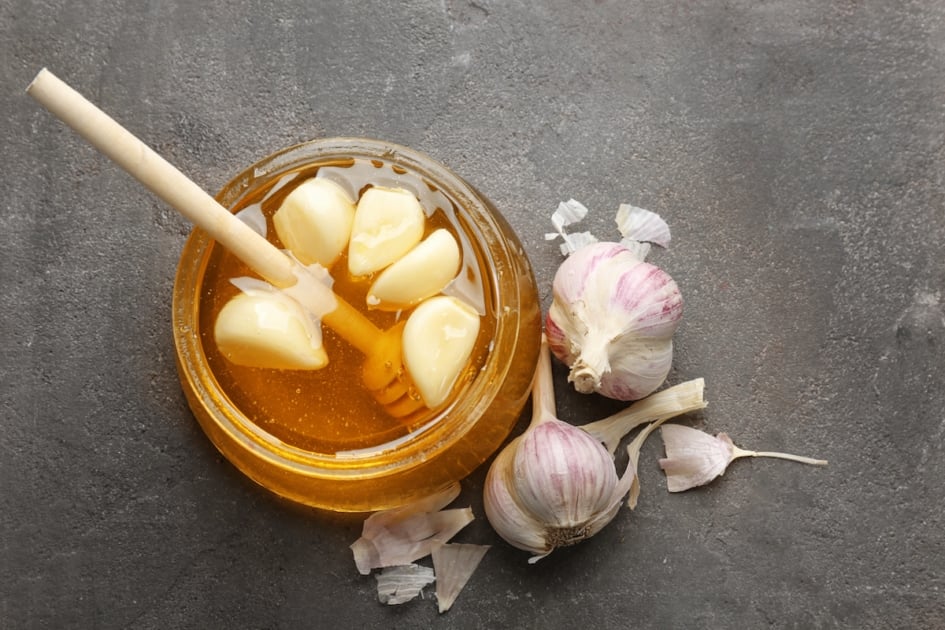
Garlic honey may not make your mouth water with anticipation, but once you read about its powerful health benefits you may decide it’s worth a taste.
Independent of each other, both honey and garlic contain powerful antioxidants that help keep your body’s immune system strong, as well as boost your brain health, protecting it from inflammatory-based diseases such as dementia and Alzheimer’s disease. Garlic has also been shown to be beneficial towards heart health by lowering blood pressure, cholesterol, and preventing clotting in blood vessels. When combined, their anti-bacterial, anti-viral, and immune-boosting properties make this powerhouse duo a worthy combatant of flourishing cold and flu germs.
Once fermented, the shelf life and versatility make this unlikely combo even more appealing. Best of all, these two superfoods can quickly be married together in a simple process, needing only two ingredients and a jar.
Honey’s antimicrobial properties make it an unlikely medium for fermentation. However, the garlic juices allow the fermentation magic to happen. Your end result is garlic that is sweetened and mellowed.
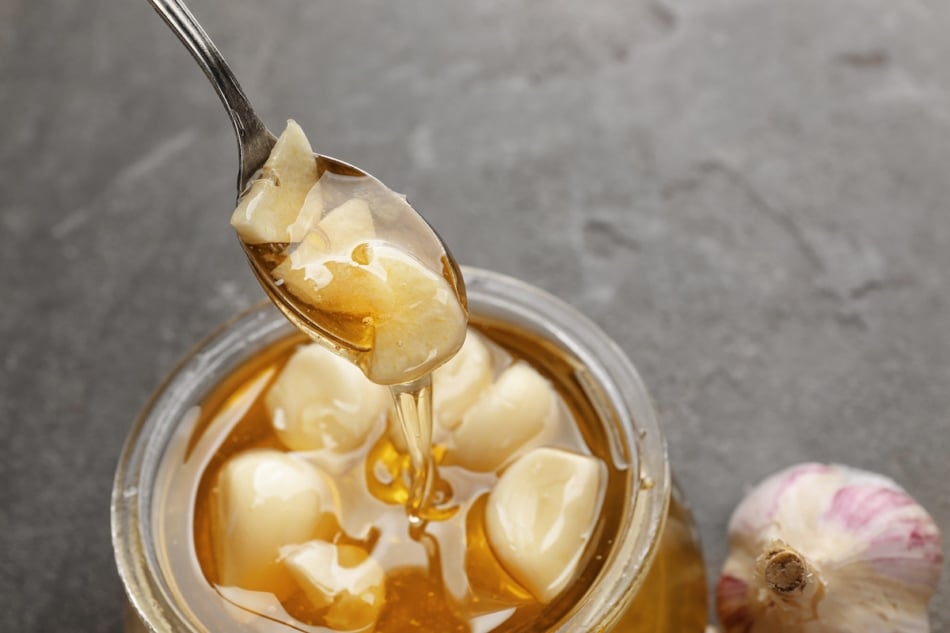
Two ingredients Is All It Takes
Making fermented garlic honey is uncomplicated and merely requires honey and garlic.
- Start with one cup of peeled garlic, the fresher, the better. Lightly crush, but don’t smash, each clove with the side of a chef’s knife (or chop large cloves in half) to release a bit of the juices from the garlic which will help thin the honey. Lightly crushing each clove allows the honey to penetrate them more easily, aiding in the fermentation process. Don’t forget to save those nutritious garlic peels to throw into your favorite homemade broth.
- Add the prepared garlic to a clean glass jar that has a lid. Pour 1 to 1 ½ cup of raw, unpasteurized honey over the garlic, just enough to completely cover the garlic and not much more. Using too much may prevent your mixture from reaching the moisture content needed for fermentation to begin. Be sure to use raw honey, as pasteurization kills off the microbes needed for fermentation. The small amount of juice released from the garlic will jumpstart the fermentation process in the honey.
- Cover your jar with a lid and place in a dark place to ferment. Place a plate under your jar as it ferments, as it will bubble up and could potentially drip out.
- Over the course of the next couple of weeks you will need to “burp” you jar daily. Open the lid to release any build-up of gases (CO2), then close and gently turn your jar over to ensure all of the garlic stays coated with honey. Be quick while opening the lid to prevent too much oxygen from being introduced during the fermentation process-just quick enough to release gases.
- In a few days, to a week, you will notice bubbles forming on the surface of the honey. The honey garlic will ferment for about a month, but you can dig into your jar at any time after one week. Over time the flavor will continue to develop. The garlic will mellow and the honey will be become runnier. It is normal for the honey and garlic to darken. Don’t be alarmed if your garlic cloves turn a blue or green hue. This is a normal reaction due to the fermentation process. The discolored garlic is safe to consume.
- Store your honey fermented garlic in a cool, dark place, away from direct sunshine. A kitchen cupboard or a pantry is the perfect home. As long as it is stored in an airtight container, and no moisture can creep in, it can last for months, or even years. If you don’t use it often, your jar may need an occasional burping to release the build-up gases, although this will slow down over time.
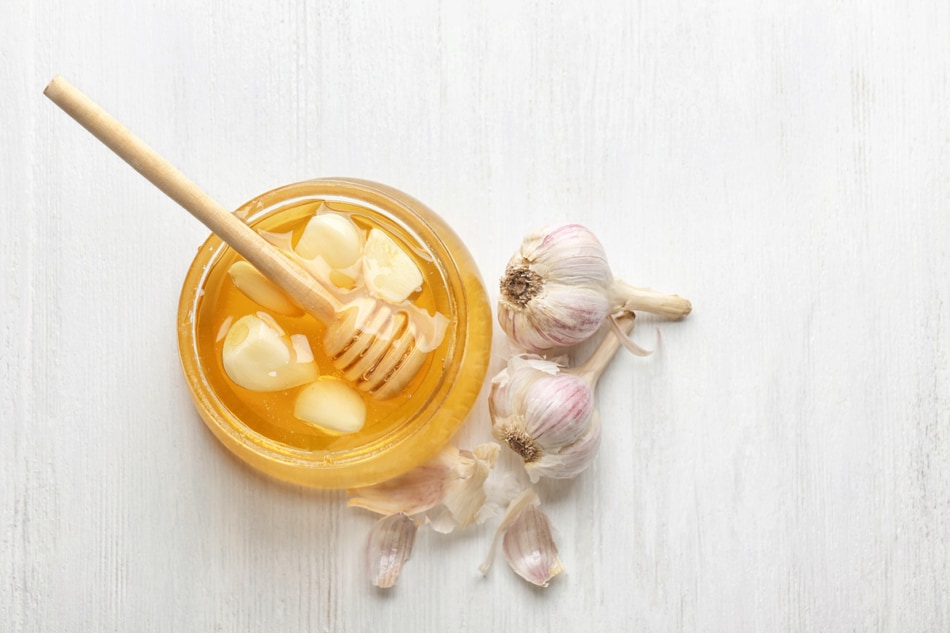
Here’s how To use fermented garlic honey
Fermented garlic honey can be used in plethora of ways. When you feel a cold or flu setting in, pop a whole clove, or take a spoonful of honey (or both!)
Garlic honey also boasts well in marinades and sauces, making a tasty glaze for meats, veggies, or basically anything you would normally use honey or garlic for.
Drizzle over pizza; serve alongside or use as a glaze for your favorite protein- friend chicken, grilled chicken, pork, shrimp, or tofu; drizzle over cheese, such as warm brie, goat cheese, or ricotta.
Use in salad dressings or marinades; spread the honey over toasty cornbread, pretzels, breakfast muffins, or toast;
Pour some over roasted or stir-fried veggies; use the mellowed garlic in dips like hummus or a white bean dip.
The uses and ideas are really endless.
Note of Caution
Though the risk is minimal, some methods of preserving garlic run the risk of carrying botulism. However, with this method, the acidity in the honey makes it improbable for bacteria to survive and multiply, which is why honey has such as significant stable shelf-life. If you are concerned about botulism, you can ease your mind by testing with a pH strip. Botulism cannot grow in acidic conditions, with a pH less than 4.6. Honey contains many kinds of acids and its pH runs around 3.9 (varying between brands). If your pH is too high, try adding a splash of apple cider vinegar to add more acidity and then retest. As always, avoid giving honey to babies under the age of one.

Natalie LaVolpe
Natalie LaVolpe is a freelance writer and former special education teacher. She is dedicated to healthy living through body and mind. She currently resides on Long Island, New York, with her husband, children, and dog.



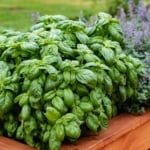
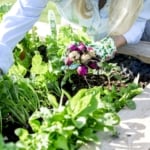

Can botulism develop at any point in the life of your honey garlic? I’ve had mine for a few months and never had a problem, but I’m not sure where my test strips are and I feel a cold coming on. And if it can develop later, would adding a splash of ACV work this far along in the process or not?
I did put a splash in when I first made it.
That’s a great question, Jessica. I was wondering the same.
can you take as maintenance if so how much a day and if sick how much and how long thank you
Where would someone buy ph test strips?
You can find them at most stores garden centers and online.
I’m on my 3rd jar in a year. I’m 67 and never liked honey. But the idea of an endless supply of garlic and it never going bad is so brilliant! What I didn’t bargain for is I now crave the honey, which tastes lovely with a hint of garlic and it thins out. I eat about 1-2 tablespoons a day usually on am empty stomach.
I’ve lost 15 stubborn pounds and now consume many fermented things. I’m a believer. Make the honey garlic in a Mason jar and don’t tighten the lid too much.
I let mine work in the fridge, it’s slower but doesn’t attract ants like crazy! I just tighten the lid and shake it now and then. Loosen the lid a little and put it back.
Thanks for a great article.
Thanks for leaving a comment Lorraine, sounds like this is really working for you!
Why should a child under 1 not taste honey…never heard of that
It has allergens and is a risk of botulism.
why not just add lemon juice or apple vinegar at the beginning to erase ANY chance of botulism?
Going to have to try this. I brine ferment my field garlic, even the ripe scapes and they make the best scampis and additions to stir fries, roasts, soups, stews and even to nibble on.
Hi Blaine,
Let us know how it turns out. Great idea about the scapes!! Thanks for reading and commenting.
it is going to be interesting searching for folks using this receipt.
I love the great information these articles provide , Thanks so much
Thanks Rosia,
Glad you find the information useful!